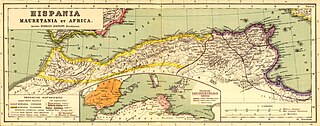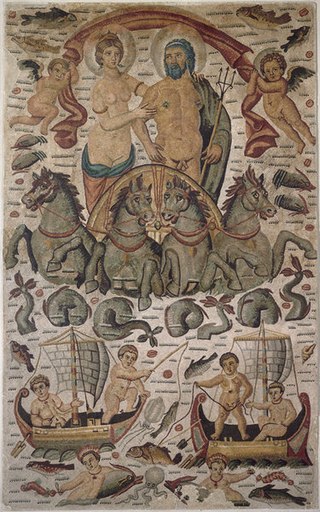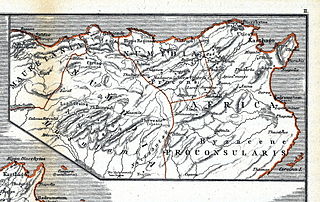 Roman Baths of Mascula | |
| Location | Algeria |
|---|---|
| Region | Khenchela Province |
| Coordinates | 35°25′00″N7°08′00″E / 35.416667°N 7.133333°E |
Mascula was an ancient Roman colonia in Numidia. It is called Khenchela in modern Algeria.
 Roman Baths of Mascula | |
| Location | Algeria |
|---|---|
| Region | Khenchela Province |
| Coordinates | 35°25′00″N7°08′00″E / 35.416667°N 7.133333°E |
Mascula was an ancient Roman colonia in Numidia. It is called Khenchela in modern Algeria.
Mascula was located in the Aurès Mountains (part of the Atlas Mountains), at 1,200 metres (3,900 ft) above sea level, and has a cool Mediterranean climate: it was one of the coldest cities in Numidia (even now it snows sometimes). The fresh location was chosen by Roman legionaries to retire as veterans. [1]
Mascula was built under Trajan and was garrisoned by the "7th company of Lusitanians". It was a castrum (with a nearby vicus) on the military road, that connected Theveste with Sitifis and that followed the slopes of the Aures mountains. Mascula was connected with the fortifications of Tinfadi, Vegesela, Claudi and Tliamugas. Mascula was the most important of these forts from a strategic point of view, because controlled the numidian access to the Sahara.
At a later period, when Christianity had been firmly established in Roman Africa, Mascula had a brief era of prosperity. Numerous Christian ornaments have been found on the site, and the names of four bishops of Mascula have been preserved—Clarus in the third century, Donatus in the fourth, Januarius at the close of the fifth, and a fourth bearing the same name early in the sixth century. It appears to have suffered terribly about the middle of the fourth century from the incursions of barbarian tribes who banded together for its destruction.......During the Byzantine occupation Solomon the general converted Mascula into a garrison town with walls of defence, and finally, when the Arabs swept over the land, its history as a town came to a close.Alexander Graham
Mascula in the fourth century was at the center of the Donatism controversy, and there are beautiful mosaics discovered from those years [2] There are even some Roman baths from the late third century, still efficiently working after recent restoration.
Mascula was even one of the centers of Romano-berber resistance against the Arabs, under queen Kahina. It seems that was renamed -after the Moslem conquest- with the name of one of the daughters of Kahina: Khenchela (meaning "angel" in berber).

Mauretania is the Latin name for a region in the ancient Maghreb. It extended from central present-day Algeria to the Atlantic, encompassing northern present-day Morocco, and from the Mediterranean in the north to the Atlas Mountains. Its native inhabitants, of Berber ancestry, were known to the Romans as the Mauri and the Masaesyli.

Numidia was the ancient kingdom of the Numidians in northwest Africa, initially comprising the territory that now makes up Algeria, but later expanding across what is today known as Tunisia and Libya. The polity was originally divided between the Massylii state in the east and the Masaesyli in the west. During the Second Punic War, Masinissa, king of the Massylii, defeated Syphax of the Masaesyli to unify Numidia into the first unified Berber state for Numidians in present-day Algeria. The kingdom began as a sovereign state and an ally of Rome and later alternated between being a Roman province and a Roman client state.

The history of North Africa during the period of classical antiquity can be divided roughly into the history of Egypt in the east, the history of ancient Libya in the middle and the history of Numidia and Mauretania in the west.

Lambaesis (Lambæsis), Lambaisis or Lambaesa, is a Roman archaeological site in Algeria, 11 km (7 mi) southeast of Batna and 27 km (17 mi) west of Timgad, located next to the modern village of Tazoult. The former bishopric is also a Latin Catholic titular bishopric.

Al-Kahina, also known as Dihya, was a Berber warrior-queen of the Aurès and a religious and military leader who lived during the seventh century AD.

The Aures Mountains are a subrange of the Saharan Atlas in northeastern Algeria. The mountain range gives its name to the mountainous natural and historical region of the Aures.

Khenchela is the capital city of the administrative Khenchela Province (Wilaya), in the north east of Algeria. Situated in the Aures Mountains, 1200 m above sea level. The city is mainly populated by Berber Chaouis.

Cirta, also known by various other names in antiquity, was the ancient Berber, Punic and Roman settlement which later became Constantine, Algeria.

Theveste was a Roman colony situated in what is now Tébessa, Algeria.

Tébessa or Tebessa, the classical Theveste, is the capital city of Tébessa Province in northeastern Algeria, near the border with Tunisia. It hosts several historical landmarks, the most important one being the wall that surrounds the city and its gates. The city is also known for its traditional Algerian carpets. Tébessa was home to over 190,000 people in 2007.

Kusaila ibn Malzam was a 7th-century Berber Christian ruler of the kingdom of Altava and leader of the Awraba tribe, a Christianised sedentary Berber tribe of the Aures and possibly Christian king of the Sanhaja. Under his rule his domain stretched from Volubilis in the west to the Aurès in the east and later Kairouan and the interior of Ifriqiya. Kusaila is mostly known for prosecuting an effective Berber military resistance against the Muslim conquest of the Maghreb in the 680s. He died in one of those battles in 688.
Hassan ibn al-Nu'man al-Ghassani was an Arab general of the Umayyad Caliphate who led the final Muslim conquest of Ifriqiya, firmly establishing Islamic rule in the region. Appointed by Caliph Abd al-Malik, Hassan launched a series of campaigns during the closing years of the 7th century, during which he defeated the Byzantines and the Berbers led by al-Kahina. The Byzantine capital of Carthage was destroyed in 698 and the nearby city of Tunis was founded in the following year. In Kairouan, Hassan set up a Muslim administration for the province to collect taxes from its Christian inhabitants and pay the troops. He enrolled thousands of Berbers into the army, which proved critical to later Muslim military successes in the Maghreb and the Iberian Peninsula. He was ultimately ousted from his post by the governor of Egypt, Abd al-Aziz ibn Marwan, due to a power struggle for influence over Ifriqiya.

Tobna, also known by the ancient names of Tubunae or Thubunae, is a ruined former city in Batna Province of Algeria, located just south of the modern city of Barika. From this position, it once controlled the eastern part of the Hodna region, while M'Sila did the west. It flourished from the time of the Roman Empire through the Islamic Middle Ages, until it was sacked and destroyed by the Banu Hilal in the 11th century, after which it was finally abandoned.

Altava was an ancient Romano-Berber city in present-day Algeria. It served as the capital of the ancient Berber Kingdom of Altava. During the French presence, the town was called Lamoriciere. It was situated in the modern Ouled Mimoun near Tlemcen.

Byzantine rule in North Africa spanned around 175 years. It began in the years 533/534 with the reconquest of territory formerly belonging to the Western Roman Empire by the Eastern Roman (Byzantine) Empire under Justinian I and ended during the reign of Justinian II with the conquest of Carthage (698) and the last Byzantine outposts, especially Septem (708/711), in the course of Islamic expansion.

Bagai was a Roman–Berber city in the province of Africa Proconsularis. It must have been of some reasonable size, as it was also the seat of an ancient Catholic bishopric. The ancient city has been identified with ruins at Ksar-Bagaï outside of Baghai, in the Aurès Mountains of the El Hamma District in Khenchela Province, Algeria.

Numidia was a Roman province on the North African coast, comprising roughly the territory of north-east Algeria.

The Mauro-Roman Kingdom, also described as the Kingdom of Masuna, was a Christian Berber kingdom which dominated much of the ancient Roman province of Mauretania Caesariensis from the capital city of Altava. Scholars are in disagreement about whether the polity aimed for independence as a kingdom or was part of a loose confederation, an alternative hypothesis drawn from contextual knowledge about Berber tribal alliances. In the fifth century, Roman control over the province weakened and Imperial resources had to be concentrated elsewhere, notably in defending Roman Italy itself from invading Germanic tribes. Moors and Romans in Mauretania came to operate independently from the Empire. However, regional leaders may not have necessarily felt abandoned by the Romans.

The Kingdom of the Aurès was an independent Christian Berber kingdom primarily located in the Aurès Mountains of present-day north-eastern Algeria. Established in the 480s by King Masties following a series of Berber revolts against the Vandalic Kingdom, which had conquered the Roman province of Africa in 435 AD, Aurès would last as an independent realm until the Muslim conquest of the Maghreb in 703 AD when its last monarch, Queen Dihya, was slain in battle.
The Battle of Tabarka was a military engagement fought between the forces of the Umayyad Caliphate and Dihya, a Berber queen. The battle took place near the city of Tabarka, Tunisia, in either 701, 702 or 703 AD. The battle resulted in a major victory for the Umayyads and the end of organized Berber resistance to the caliphate.